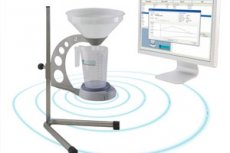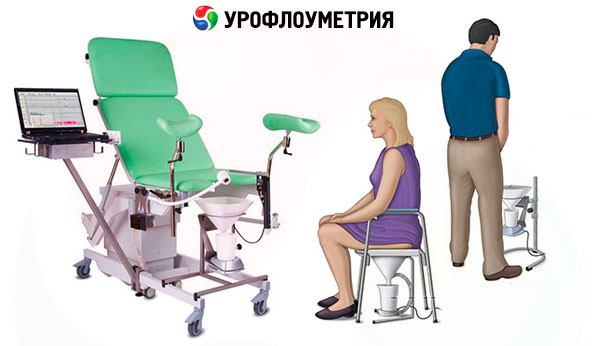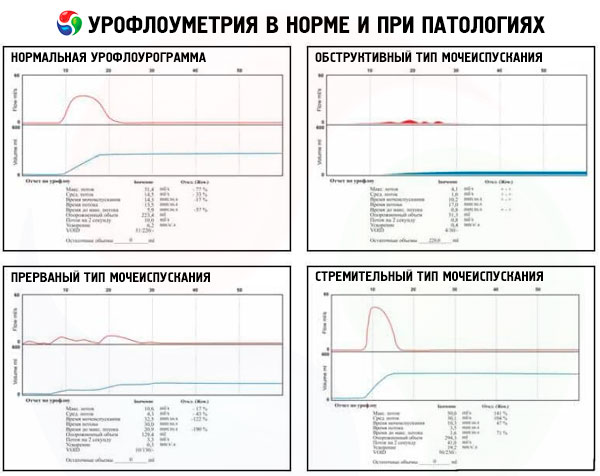Uroflowmetry
Last reviewed: 23.04.2024

All iLive content is medically reviewed or fact checked to ensure as much factual accuracy as possible.
We have strict sourcing guidelines and only link to reputable media sites, academic research institutions and, whenever possible, medically peer reviewed studies. Note that the numbers in parentheses ([1], [2], etc.) are clickable links to these studies.
If you feel that any of our content is inaccurate, out-of-date, or otherwise questionable, please select it and press Ctrl + Enter.

Uroflowmetry is a non-invasive screening test for detecting possible dysfunction of the lower urinary tract. In her, the parameters of the flow of urine are measured.
The function of the lower urinary tract is to accumulate and evacuate urine. The urinary bladder passively accumulates urine, then comes the act of urination associated with the reflex relaxation of the sphincter and the contraction of the detrusor (urination is the main event of the corresponding reflex).
Indications for conduction
Today uroflowmetry is actively used for a wide range of urological diseases:
- prostate adenoma,
- prostate cancer,
- chronic prostatitis,
- stricture of the urethra in men,
- chronic cystitis and symptoms of impaired urination in women,
- vesicoureteral reflux,
- infection of the lower urinary tract,
- enuresis in children,
- neurogenic micturition dysfunction of the GMF,
- urinary incontinence in all patient categories.
Methods of uroflowmetry
The principle of uroflowmetry is to record the volume flow rate of urine during urination. To measure the parameters of urination, the most commonly used weight. Less often - rotational or electronic sensors. The sensor is mounted on a stable platform. The device is also equipped with an electronic recording device with a microprocessor. The latest models of uroflowmeters can transmit data to a personal or handheld computer via WiFi or BlueTooth wireless channels. Periodically, the instrument must be calibrated (usually using a special device).
The patient comes to the study with an average filling of the bladder, which corresponds to a normal urge to urinate of moderate intensity (volume of urine 150-500 ml). The patient is previously explained the meaning and methodology of the study. Urination should be as natural and free as possible, without additional effort. Men are offered to urinate standing, women - sitting (for which a special chair is set over the appliance). After completion of the study, determine the volume of residual urine by ultrasound scanning or catheterization. It is most convenient to measure the residual urine using a special portable standardized ultrasound device.

Explanation of results
The following parameters are used to interpret the study:
- the maximum speed of urination is Qmax (ml / s);
- the average speed of urination is Qsr (ml / s);
- time to reach the maximum speed (s);
- time of urination (s);
- flow time (s):
- volume of excreted urine or volume of urination (ml);
- volume of residual urine (ml).
An important stage in the evaluation of the result of the study is the analysis of the urine release schedule (urinary curve) and digital information. The normal curve has the shape of a bell. With a stricture of the urethra, a curve in the form of a "plateau". Uroflowmetry curve with obstruction or weakness of detrusor is characterized by a decrease in the maximum rate of urination. A curve with a rapid rise to Qmax, less than 1 second from the onset of urination ("rapid urination") is typical of a hyperactive bladder (GMF). It is characteristic that in one-phase urination, the time of urination is equal to the time of the flow of urine, and when urinating in several receptions, the time of urination is longer than the time of the flow of urine.
The main digital uroflowmetric indicator is Qmax. Values of Qmax greater than 15 ml / s are usually considered normal. Uroflowmetry is assessed with a voiding volume of 150 to 450 ml. At adults at volumes less than 150 ml and more than 500 ml results of research are poorly informative.
The lower limit of the norm in terms of the maximum urinary flow rate, depending on age and sex (according to Abrams P., 2003)
|
Age, years |
Minimal volume of urination, ml |
Men, ml / s |
Women, ml / s |
|
4-7 |
100 |
10 |
10 |
|
8-13 |
100 |
12 |
15 |
|
14-45 |
200 |
18 |
21 |
|
46-65 |
200 |
12 |
15 |
|
66-80 |
200 |
9 |
10 |
It was found that the maximum flow rate of urine depends on the sex, the patient's age, the volume of urination and the conditions of the study. As early as 1984 Abrams showed the presence of a nonlinear relationship between the allocated volume of urine and Q.
There are additional factors that affect the rate of urination: abdominal pressure and physiological delay due to the patient's anxiety and a sense of inconvenience caused by the need to urinate among the testing equipment in the presence of the medical staff. In this situation, an arbitrary tension of the abdominal press to facilitate urination provokes the appearance of abnormally high Q max bursts on the background of a characteristic discontinuous curve. In this regard, to obtain more reliable uroflowmetry data, it is recommended to perform at least two times in conditions of functional filling of the bladder (for adults 150-350 ml), when a natural urge to urinate occurs. In a number of clinical cases, uroflowmetry monitoring can be recommended for a longer time to obtain a visual picture.
One of the most frequent clinical problems, in solving which uroflowmetry is used, is the diagnosis of infravesical obstruction (IVO) in elderly men. The work of Abrams, Grifith shows the dependence of the presence of infravesical obstruction from the Q max index .
It should be noted that the specificity of uroflowmetry for determining infravesical obstruction is low (especially at values of Qmax within 10-15 ml / s), as in some elderly men the symptoms of impaired urination may be due to detrusor weakness or neurogenic dysfunction.
To compare the results of uroflowmetry with each other. Conducted at different times with different volumes of urination or in patients of different ages, use special nomograms. The most common of them are: Syroki (1979) - for men, Liverpool (1989) - for men and women. At the present time, modified nomograms adapted according to gender and for each age group are proposed.
To increase the informative value, uroflowmetry should be assessed not only by the value of Qmax, but also taking into account all indicators. As a result, uroflowmetry concludes that what type of urination is observed in this patient:
- obstructive;
- non-obstructive;
- ambiguous;
- "Impetuous";
- intermittent.

Despite the fact that uroflowmetry is only a screening test, the method gives the expert extremely important objective information about the nature of urination disorders, allowing in a number of cases to perform differential diagnosis of various conditions and to isolate patient groups for further urodynamic studies. In other words, uroflowmetry is an objective indicator of urination disorders, often determining a further diagnostic pathway. At the moment, uroflowmetry has become an obligatory method of examination in the protocols for managing the vast majority of lower urinary tract diseases in adults and children. That is why the presence of uroflowmetry equipment is necessary in all offices and departments with urological reception.
What do need to examine?
What tests are needed?


 [
[